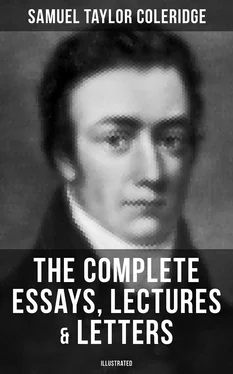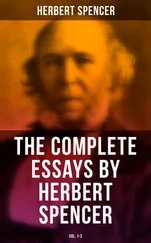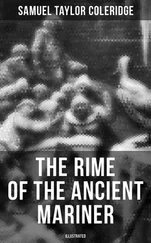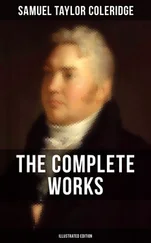Fourth; the perfect truth of nature in his images and descriptions as taken immediately from nature, and proving a long and genial intimacy with the very spirit which gives the physiognomic expression to all the works of nature. Like a green field reflected in a calm and perfectly transparent lake, the image is distinguished from the reality only by its greater softness and lustre. Like the moisture or the polish on a pebble, genius neither distorts nor false-colours its objects; but on the contrary brings out many a vein and many a tint, which escape the eye of common observation, thus raising to the rank of gems what had been often kicked away by the hurrying foot of the traveller on the dusty high road of custom.
Let me refer to the whole description of skating, vol. I. page 42 to 47, especially to the lines
“So through the darkness and the cold we flew,
And not a voice was idle. with the din
Meanwhile the precipices rang aloud;
The leafless trees and every icy crag
Tinkled like iron; while the distant hills
Into the tumult sent an alien sound
Of melancholy, not unnoticed, while the stars,
Eastward, were sparkling clear, and in the west
The orange sky of evening died away.”
Or to the poem on THE GREEN LINNET, vol. I. page 244. What can be more accurate yet more lovely than the two concluding stanzas?
“Upon yon tuft of hazel trees,
That twinkle to the gusty breeze,
Behold him perched in ecstasies,
Yet seeming still to hover;
There! where the flutter of his wings
Upon his back and body flings
Shadows and sunny glimmerings,
That cover him all over.
While thus before my eyes he gleams,
A Brother of the Leaves he seems;
When in a moment forth he teems
His little song in gushes
As if it pleased him to disdain
And mock the Form which he did feign
While he was dancing with the train
Of Leaves among the bushes.”
Or the description of the blue-cap, and of the noontide silence, page 284; or the poem to the cuckoo, page 299; or, lastly, though I might multiply the references to ten times the number, to the poem, so completely Wordsworth’s, commencing
“Three years she grew in sun and shower” —
Fifth: a meditative pathos, a union of deep and subtle thought with sensibility; a sympathy with man as man; the sympathy indeed of a contemplator, rather than a fellow-sufferer or co-mate, (spectator, haud particeps) but of a contemplator, from whose view no difference of rank conceals the sameness of the nature; no injuries of wind or weather, or toil, or even of ignorance, wholly disguise the human face divine. The superscription and the image of the Creator still remain legible to him under the dark lines, with which guilt or calamity had cancelled or cross-barred it. Here the Man and the Poet lose and find themselves in each other, the one as glorified, the latter as substantiated. In this mild and philosophic pathos, Wordsworth appears to me without a compeer. Such as he is: so he writes. See vol. I. page 134 to 136, or that most affecting composition, THE AFFLICTION OF MARGARET —— OF —— , page 165 to 168, which no mother, and, if I may judge by my own experience, no parent can read without a tear. Or turn to that genuine lyric, in the former edition, entitled, THE MAD MOTHER, page 174 to 178, of which I cannot refrain from quoting two of the stanzas, both of them for their pathos, and the former for the fine transition in the two concluding lines of the stanza, so expressive of that deranged state, in which, from the increased sensibility, the sufferer’s attention is abruptly drawn off by every trifle, and in the same instant plucked back again by the one despotic thought, bringing home with it, by the blending, fusing power of Imagination and Passion, the alien object to which it had been so abruptly diverted, no longer an alien but an ally and an inmate.
“Suck, little babe, oh suck again!
It cools my blood; it cools my brain;
Thy lips, I feel them, baby! They
Draw from my heart the pain away.
Oh! press me with thy little hand;
It loosens something at my chest
About that tight and deadly band
I feel thy little fingers prest.
The breeze I see is in the tree!
It comes to cool my babe and me.”
“Thy father cares not for my breast,
‘Tis thine, sweet baby, there to rest;
‘Tis all thine own! — and if its hue
Be changed, that was so fair to view,
‘Tis fair enough for thee, my dove!
My beauty, little child, is flown,
But thou wilt live with me in love;
And what if my poor cheek be brown?
‘Tis well for me, thou canst not see
How pale and wan it else would be.”
Last, and preeminently, I challenge for this poet the gift of Imagination in the highest and strictest sense of the word. In the play of fancy, Wordsworth, to my feelings, is not always graceful, and sometimes recondite. The likeness is occasionally too strange, or demands too peculiar a point of view, or is such as appears the creature of predetermined research, rather than spontaneous presentation. Indeed his fancy seldom displays itself, as mere and unmodified fancy. But in imaginative power, he stands nearest of all modern writers to Shakespeare and Milton; and yet in a kind perfectly unborrowed and his own. To employ his own words, which are at once an instance and an illustration, he does indeed to all thoughts and to all objects —
“ —— — add the gleam,
The light that never was, on sea or land,
The consecration, and the Poet’s dream.”
I shall select a few examples as most obviously manifesting this faculty; but if I should ever be fortunate enough to render my analysis of Imagination, its origin and characters, thoroughly intelligible to the reader, he will scarcely open on a page of this poet’s works without recognising, more or less, the presence and the influences of this faculty. From the poem on the YEW TREES, vol. I. page 303, 304.
“But worthier still of note
Are those fraternal Four of Borrowdale,
Joined in one solemn and capacious grove;
Huge trunks! — and each particular trunk a growth
Of intertwisted fibres serpentine
Up-coiling, and inveterately convolved;
Not uninformed with phantasy, and looks
That threaten the profane; — a pillared shade,
Upon whose grassless floor of red-brown hue,
By sheddings from the pinal umbrage tinged
Perennially — beneath whose sable roof
Of boughs, as if for festal purpose, decked
With unrejoicing berries — ghostly shapes
May meet at noontide; FEAR and trembling HOPE,
SILENCE and FORESIGHT; DEATH, the Skeleton,
And TIME, the Shadow; there to celebrate,
As in a natural temple scattered o’er
With altars undisturbed of mossy stone,
United worship; or in mute repose
To lie, and listen to the mountain flood
Murmuring from Glazamara’s inmost caves.”
The effect of the old man’s figure in the poem of RESOLUTION AND INDEPENDENCE, vol. II. page 33.
“While he was talking thus, the lonely place,
The Old Man’s shape, and speech, all troubled me
In my mind’s eye I seemed to see him pace
About the weary moors continually,
Wandering about alone and silently.”
Or the 8th, 9th, 19th, 26th, 31st, and 33rd, in the collection of miscellaneous sonnets — the sonnet on the subjugation of Switzerland, page 210, or the last ode, from which I especially select the two following stanzas or paragraphs, page 349 to 350.
“Our birth is but a sleep and a forgetting:
The Soul that rises with us, our life’s Star,
Hath had elsewhere its setting,
And cometh from afar.
Not in entire forgetfulness,
Читать дальше












